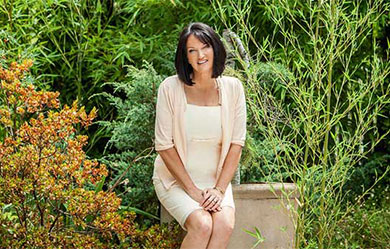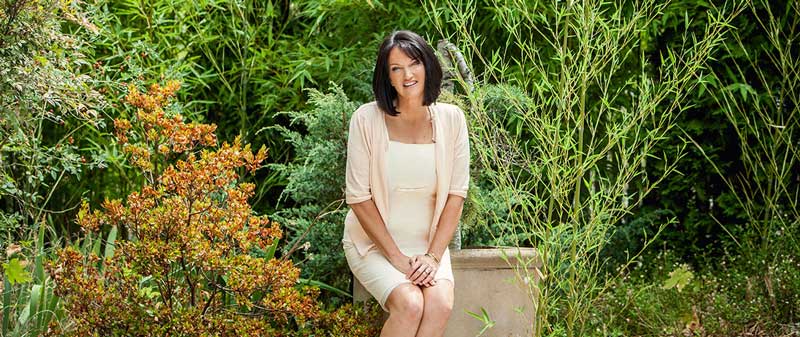
Therese Kerr (above) always wanted four children but, after surgery in 1995 for severe endometriosis, that dream evaporated – albeit blessed as she already was with daughter Miranda and son Matthew.
In 2001 she discovered she had tumours on her spleen, leading to its removal.
‘This was a wake-up call and from that point I started in earnest to address what I was putting on and in my body,’ says the author and speaker on wellness, an ambassador for Australian Organic and managing director of certified organic personal care range, Divine by Therese Kerr. Need we add she is also mum of an international supermodel.
At this week’s Australasian Spa Association (ASpa) annual conference in Melbourne, Therese addressed the audience about the need to become aware of the nature of the ingredients in personal care products and educate ourselves about the potential effects they can have on the body.
‘I believe a lot of the health problems I suffered were related to the many chemicals we are exposed to in our society; not just in the foods we eat but the products we use on our skin, hair and to clean our teeth,’ she said.
‘I used to lather myself in chemical-based, highly perfumed body wash and body lotion every night before bed and I was not eating as healthily as I could have been. I truly believe these poor choices contributed to my illness.
‘Since then I have been a sponge for information on holistic health and wellness. I educated myself about leading a non-toxic life.’
Part of this process has seen Therese, husband John and son Matthew move from Sydney to a property near Murwillumbah on the far northern NSW coast.
‘I’m living my Nirvana with my chooks and a veggie patch,’ she laughed. ‘Now I’m the healthiest I’ve ever been and I want to share the knowledge I’ve gained so people can make more informed choices.’
Therese told the ASpa attendees that there are now more than 10,500 chemicals found in conventional, everyday personal care products, of which, according to the Environmental Working Group (EWG), only 13 percent have ever been tested for safety in cosmetics.
‘In addition, 65-70 per cent of what you put on your skin goes directly into your organs and bloodstream,’ she said. ‘As your skin absorbs chemicals up to 10 times faster than by way of ingestion, what you put on your skin is equally as important, if not more important, than what we actually consume by way of food and drink.
‘It is so important to only put on your skin what you are happy to put in your mouth.’
Even many so-called ‘natural’ brands fall way short, in Therese’s opinion. ‘I have been researching and testing many `natural’ brands and a few of them fail the test because when you read the fine print there are many chemical ingredients, and that’s not natural at all.’
Therese’s speech comes hot on the heels of findings released last week by the Australian Competition and Consumer Commission (ACCC) that cosmetics accounted for around 30 percent of injury reports in the past year.
Thousands of Australians every year are being injured from wrongly labelled products, with some consumers succumbing to severe allergic reactions.
‘We see skin infections, bacterial conjunctivitis, folliculitis, corneal ulcers and anaphylactic shocks, which is why ingredients labelling is very important indeed,’ said deputy chair of the ACCC Delia Rickard.’
The ACCC receives mandatory injury reports when a supplier becomes aware that a product has or may have caused death, serious injury or illness.
The consumer watchdog also does regular surveys on cosmetic products and is this year focusing on products which have no ingredient labelling and where ingredient labelling is in a language other than English.
It says the cosmetic labelling standard helps consumers identify ingredients that they may be allergic or sensitive to.
‘People who make and supply cosmetic products need to be fully aware of their responsibilities,’ said Ms Rickard. ‘An inaccurate list of ingredients, or a product without a label could see consumers with allergies exposed to harm.’
During 2012-13, the ACCC started an audit of cosmetic-related injury reports received during 2011. The main observations were that many of the reports involved injuries from face washes, creams, body wash products and creams and deodorants. It also found that while labelling was generally good, some products had ingredient labelling that was inconsistent.
In mid-2013 the ACCC also investigated whether microbiological contamination may be to blame for some of the reported injuries.
A survey of products sold in Australia saw three out of 112 products tested returned high microbial counts.
‘It is a timely reminder as the trend to produce all natural and all organic products may increase pressure on manufacturers to produce cosmetics with less preservatives or less effective natural preservatives,’ said Ms Rickard.

All of this puts an onus of responsibility on salon, spa and clini owners and their teams to be fully informed about the products they are using on and recommending to their clients.
By having that knowledge it also creates a huge opportunity to strengthen relationships with clients; to engender trust and confidence that they will receive the best treatment for their skin type and condition. You then have the opportunity to become the go-to for subsequent product purchases, as well as treatments.
Many skin conditions such as acne, dermattitis, diffuse redness and hypersensitivity are caused or aggravated by clients using the wrong products on their skin, according to leading Sydney dermal therapist Dee Davies, of Clear Skincare in Double Bay.
‘I spend the first consultation asking a lot of questions,’ she says. ‘In the modern world there are so many varieties of skin products.
‘The average clients I see are shopping on the net, so they really don’t know what they are purchasing. Many of the products they have bought are overloaded with active ingredients and they didn’t know how to use them – or whether they should have been using them at all.
‘This makes any therapist’s job hard when skins are so sad – drained of all moisture, clogged, red and just worn out – from jumping from one product range to the next.
‘I generally take everything off them and go back to basics. However, there are cases where it’s obvious that they need to see a doctor before starting on any skin repair program. The issue may need medical intervention before results can be achieved, such as with acne.’
Factors such as hormones, stress, certain health conditions that alter the body’s chemistry, medications and environmental aggressors like UV exposure can all disturb the protective acid mantle of the skin, according to Matoyla Kollaras, director of Skin Factors, distributors in Australia of Christina Cosmeceuticals and Ahava Dead Sea salt skincare.
‘However, the major culprit is the use of soap, lotions and other skin care products that have not been formulated with skin- friendly pH levels.
‘Cleansers are by far the worst offenders, especially those with a strong detergent action. Many products on the commercial market contain ingredients such as sodium laurel sulfate, which strip the acid mantle.
‘The pH level of most cleansers is slightly higher than 5.5, so the cleanser can break down dirt and oil on the skin. However, some – especially bar soap – typically have a pH level of 9 to 12, which is far too high, wearing away at the skin’s acid mantle.
‘Excessive cleansing is another factor in breaking down the acid mantle, as is over- exfoliating. When skin pH levels move outside the normal range for long periods of time, certain skin conditions like dermatitis and infection can develop. High alkaline pH levels can leave the skin vulnerable to bacteria and conditions such as Staphylococcus can develop and acne and rosacea will worsen.’
“




